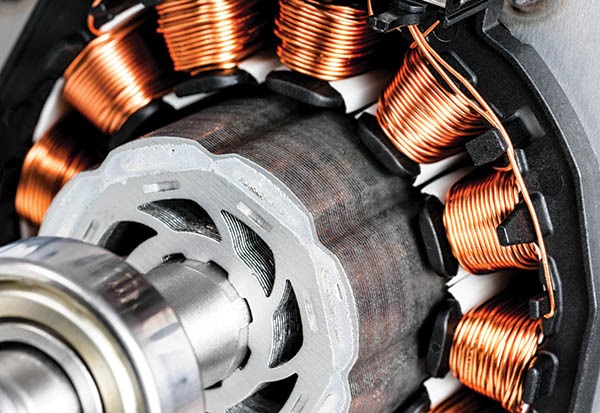Permanent magnets
Permanent magnets are ‘hard’ magnetic materials, i.e., materials that, once magnetized, retain their magnetization at the temperature of use. Their magnetic properties are primarily determined by the properties of the compounds that constitute them. Also, they depend a lot on the microstructure of the material obtained through the manufacturing process.
Four families of materials for permanent magnets are used in most applications in the market. These are alnicos, hard ferrites, samarium-cobalt, and neodymium-iron-boron. There are also other materials, but their applications are very limited. These are: ductile alloys, manganese-aluminium-carbon alloys, hard martensitic steels, or micro powder-based magnets.
The term permanent magnet comes from the magnet’s ability to retain an induced magnetic charge after it is removed from the magnetizer. Permanent magnets are needed to make compasses, radio transmitters, various electrical measuring instruments etc. Usually, they are made of steel with high carbon content. Permanent magnets are starting to be used in a new highly magnetizable alloy called magnico, which consists of cobalt, nickel, copper, aluminium, and iron.
global-permanent-magnets-market
The need among oil & gas industry players to enhance the usage of energy-intensive technological processes like electronic submersible pumps and reduce power consumption represents a lucrative opportunity for the market vendors of the permanent magnet. As compared to asynchronous submersible electric motors, which are used for driving electrical submersible pumps, permanent magnet motors have a number of characteristics that make them economically attractive for the oil & gas industry.
Best metals to use in a magnetic circuit
Solid steel is generally the best choice, from an economic point of view, in static field devices. Low carbon steel (ASME 1006 – 1018) should be used for pole parts, if possible, and should be enriched with hydrogen after processing. The 400 series stainless steels can be used, but they are not as good magnetically as low carbon steel, so parts may have to be larger to compensate.
Difference between AlNiCo, SmCo, and NdFeB magnetic materials
AlNiCo is an older magnetic material that still has important applications. Its maximum energy product is about 1/5 of SmCo materials, but it has excellent properties at high temperatures and better corrosion resistance. AlNiCo can be cast in different shapes with different magnetic orientations. AlNiCo magnets have been widely used, initially in military electronic applications and later in civilian versions such as automotive and aircraft sensor applications. The development of Alnico magnets marked the beginning of a new way of thinking about magnetic materials where composite materials with multiple phases produced attribute superior to those of the individual components.
The drive towards neodymium-iron-boron (NdFeB) magnets was a result of the increased cost of Co in the late 1970s, a critical ingredient in the SmCo magnets.
SmCo and NdFeB rare earth magnets have high coercivity, so they do not need to be magnetized in the circuit and can be used with low permeability coefficients (i.e., thin disks). These materials are also suitable for testing the Helmholtz coil due to their normal straight-line curves. This also makes rare earths ideal for engines and high field dipoles. SmCo has good resistance to thermal demagnetization but is fragile. NdFeB is less brittle, has poor thermal properties and is prone to corrosion.
permanent-magnets-market-share-by-material
Advantage of a permanent magnet compared to an electromagnet
In general, the space volume necessary to produce a certain static field will be lower for permanent magnets when the working space is small; electromagnets win in larger devices. The limiting factors for electromagnets are the space consumed by the windings, the power supply and the heat generated during operation. Permanent magnets do not require a power supply, so they save space and energy. An adjustable power supply makes it easy to adjust the magnetic field of an electromagnet by simply adjusting the input current. However, adjustable permanent magnets can be used if the field does not need to be adjusted frequently.
Why are rare earths magnets so expensive?
In the case of rare earths magnets, the metals used to improve the magnetic properties are difficult to extract. The magnet-related elements are a small fraction of the lanthanides mined, so material cannot be produced in huge quantities. Since the fine powders are pyrophoric, production conditions need to be very tightly controlled, and there is a limit to the size of block that can be formed due to the pressure required. Subsequent processing of the magnets increases the costs. As the magnets are typically very hard, grinding and processing operations are slow.
Role of magnets in green energy
Magnetic materials especially permanent magnets are critical for the efficient performance of many renewable energy technologies. The increased reliance on renewable energy sources has accelerated research in energy-related technologies the world over. The use of rare earth metals in permanent magnets continues to be a source of greater concern owing to the limited rare earths supply coupled with dwindling reserves on the globe.
The drive behind the development of permanent magnets emanates from the need to obtain high magnetic energy product over smaller volumes of magnets, which could be utilised in a few technological applications such as clean energy technologies (wind turbine generators and hybrid regenerative motors), transportation components, and consumer products. Magnetic materials play a pivotal role in modern society owing to their unique ability to perform several tasks as follows: convert mechanical to electrical energy; transmit and distribute electric power; facilitate microwave communications; provide basis for data storage systems (Wallace Matizamhuka – The Impact of Magnetic Materials in Renewable Energy).
NdFeB permanent magnets enable the replacement of mechanical gearboxes in wind turbines with direct-drive permanent magnet generators thus reducing the overall turbine weight, cost of other components such as concrete and steel required to support heavy gearboxes, and a reduction in the number of moving parts which basically allows for greater reliabilities and efficiencies. Permanent magnet synchronous generators use the magnetic field of strong rare earth magnets to convert the energy from the spinning blades into electricity. These generators can operate at low speeds, which allows them to be powered by the turbine shaft directly, eliminating the need for a gearbox. This reduces the weight of the wind-turbine nacelle. The elimination of the gearbox results in improved reliability lowered maintenance costs and improved efficiency. The properties of magnets that allow designers to eliminate mechanical gearboxes from wind turbines illustrate how magnets can be used innovatively in solving both operational and economic problems in modern wind turbines.
Today, electric/hybrid electric vehicles have re-emerged as a realistic alternative to gasoline internal combustion vehicles. The success of EVs is owed to the highly efficient permanent magnet motors used to run the power train of the EV. The use of hard magnetic material NdFeB offers quite significant benefits, which has enabled the development of highly efficient traction motors not possible with other technologies.
Instead of wind rotating turbines, hydropower uses flowing water. Hydropower technologies generate power by using the elevation difference, created by a dam or diversion structure, of water flowing in on one side and out, far below, on the other. Water flows through the dam and turns a large wheel called a turbine. The turbine turns a shaft which rotates a series of magnets past copper coils and a generator to produce clean, renewable electricity.
Solar power uses solar panels to convert energy from the sun into thermal or electrical energy. In the manufacture of these solar panels, thin films are deposited in multiple layers through a process called ‘sputtering’ or PVD (physical vapor deposition). To optimize this process, permanent magnet assemblies improve the utilization of the material being deposited.
Magnets are used to create electrical currents in the geothermal process. As the hot fluid expands and creates the mechanical energy needed to turn the turbine blades, the turbine spins magnets inside a large coil, creating an electrical current.
The use of soft magnetic materials in transformers for power generation and conversion for the electrical grid plays a pivotal role in electricity generation. The performance of soft magnets is material specific and is dominated by properties such as low coercivity and core losses, high saturation magnetisation, resistivity, and permeability, which makes these materials more attractive for the efficient transmission and distribution of electricity.
Magnets for the oil & gas sector
The oil and gas industry presents some of the most challenging environments and demanding applications for magnets and magnetic assemblies. For this industry it is recommended to use rare earth magnets, such as neodymium and samarium cobalt magnets. This is due to their highly desirable properties such as their high coercive force and high-temperature stability. While samarium cobalt magnets have corrosion resistant properties, neodymium magnets do not. Moreover, rare earth magnets are used to remove scales that are created by aging oil equipment, pipes, and unwanted ferrous materials.
In conclusion, the properties of magnets are widely used in various fields, being useful for all mankind. Source: https://energyindustryreview.com/metals-mining/powering-the-world-with-magnets/

 English
English


